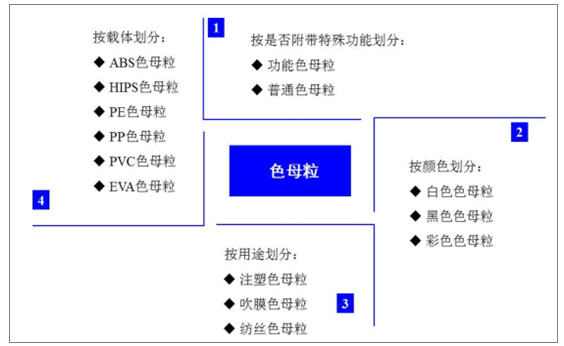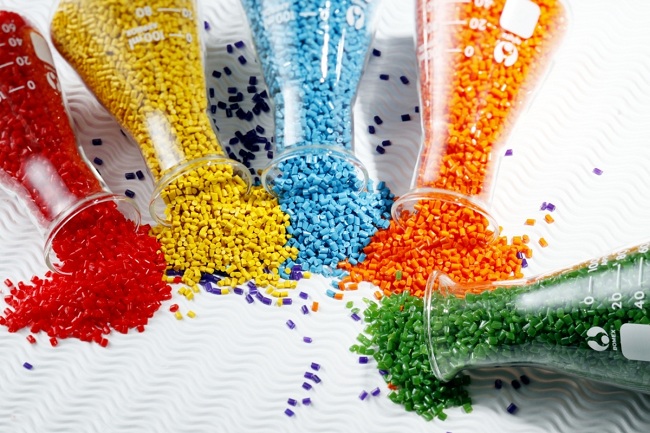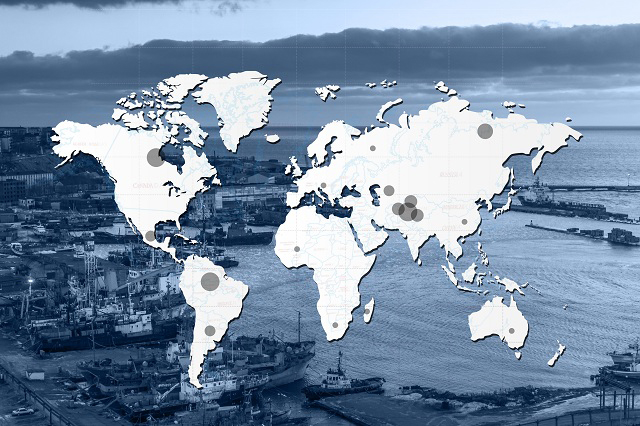



Analysis of the Status Quo of Masterbatch
The Chinese masterbatch industry started in the mid-1970s. After more than 30 years, especially the rapid development in the 1990s, the current masterbatch industry in China has reached an annual production capacity of 300,000 tons, which can basically meet the needs of the plastics and chemical fiber industries.
In the next few years, China's masterbatch industry is expected to enter a steady development, moving toward multi-functionality, high pigment content and high technology content.

Regional characteristics are obvious
China's masterbatch industry is currently showing a strong south, strong north, weak east and strong west. Manufacturers with an annual production capacity of more than 1,000 tons are the pillars of industry development. There are more than 250 masterbatch production enterprises in China, of which more than 50 large-scale enterprises have a capacity of more than 60% of the total production capacity, mainly concentrated in Guangdong, Jiangsu, Zhejiang and Shanghai. In particular, large enterprises with an annual output of more than 1,000 tons mainly gather. in the South.
This distribution also shows the same trend as China's economic development. Some excellent masterbatch enterprises can customize the masterbatch varieties according to customer requirements. Each company has its own characteristics and expertise, which can basically meet the needs of domestic customers. Many masterbatch factories can also produce functional masterbatch and plastics. Modified material.
According to the geographical distribution of domestic masterbatch production capacity, Guangdong has the largest production capacity, accounting for 41.82% of the total production capacity; Jiangsu, Zhejiang and Shanghai account for 33%; Shandong 10.62%. These regions account for more than 85% of China's masterbatch production capacity. It can be seen that the southeast coast is the main area for the development of the Chinese masterbatch industry.

Variety tends to be diverse
China's masterbatch varieties are relatively complete, and general-purpose products can fully meet the needs of the domestic plastics processing industry. The distribution of domestic masterbatch varieties, color masterbatch varieties according to color analysis, black and white masterbatch almost accounted for 80% of the total masterbatch capacity, color masterbatch only accounted for 20%, there is still a large part of the need to rely on imports .
In masterbatch production, fiber masterbatch requires higher technology and raw materials, and the production of masterbatch production technology is also due to the coloration of polypropylene fiber. The annual output of domestic fiber masterbatch has reached 2.6 tons, accounting for 10% of the total masterbatch capacity. It can be seen that the masterbatch, which is the technology invented to solve the problem of polypropylene coloring, has been more widely used in the field of plastic coloring.
PET and PP fiber develop faster in China, while PA fiber has a smaller market share. The distribution ratio of PET, PP and PA fiber masterbatch is currently 68.2%, 30.2% and 1.6% respectively. With the establishment of multinational PA projects in China, the development and production of PA masterbatches in China must also catch up.
With the rapid development of engineering plastics in China in recent years, engineering plastics such as PA, PC, fluoroplastics and special engineering plastics have placed higher demands on masterbatch. The School of Materials Science and Engineering of Beijing University of Chemical Technology has successfully developed polyfluoroethylene propylene masterbatch, which has filled the domestic gap. In the development process, it has solved the problems of raw material selection, formulation and production process adjustment, and successfully prepared white, Yellow, green, blue, red, orange, brown, black full color polyfluoroethylene propylene masterbatch, applied to wire and cable, electrical properties and mechanical properties indicators fully meet the requirements. The successful development of this project has laid a good theoretical and practical foundation for the development of high-grade masterbatch for engineering plastics in China.

Foreign businessmen are rushing to the beach
China has become one of the largest producers and producers of masterbatch in Asia and is also the world's largest demand market in the future. According to relevant information, the demand for masterbatch in other Asian countries is growing at an average annual growth rate of about 7% to 9%, while the annual growth rate of demand for masterbatch in China is about 20%. China will become the fastest growing demand for masterbatch. Market. This tempting cake has attracted international masterbatch giants to rush to the Chinese market.
In the 1990s, foreign masterbatch companies began to enter China. In September 2000, GeonandM.A.Hanna co-founded POLYONE, the world's largest polymer service company, and established masterbatch and engineering plastics production bases in Shanghai, Suzhou and Shenzhen, China. In September 2005, the POLYONE Shenzhen base was extensively expanded and seven production lines were built.
Clariant Masterbatch is the world's largest supplier of color masterbatch and functional masterbatch. It has been active in the Chinese market since 1995. It has a full-service factory in Guangzhou and Beijing. In November 2004, Shanghai Xinzhuang Industrial Co., Ltd. The park has also established a third production base in China, which mainly provides color and functional masterbatch services to East China and international customers.
PCC, a subsidiary of PMC, is building a masterbatch plant in Nanjing. The first phase of the project is expected to produce 50 tons/month of liquid color masterbatch for PET blowing. The pigments are mainly used by companies such as BASF and Ciba. The second phase of the project is expected to produce solid color masterbatches.
In addition to the original United States, Switzerland, Japan, Singapore, South Korea, etc. are also building factories in China, especially some special engineering plastic color masterbatch varieties have an advantage, grabbing the high-end market of masterbatch, further intensifying competition.

Diversified raw materials
The quality of the masterbatch depends to a large extent on the supply of raw materials such as pigments and dispersants. China's plastic pigments have made great progress after years of development. Domestic pigments such as Jiehong, Lily, Yabang and some titanium dioxide and carbon black enterprises have higher quality and can meet the requirements of masterbatch. Foreign pigment manufacturers DuPont, Clariant, Ciba, BASF, etc. have set up factories in China, providing high-grade pigments for domestic masterbatch production. Domestic pigments are comparable to foreign mid-range pigments, but there is still a gap in product purity, especially pigment surface treatment, compared to high-grade pigments.
The dispersant is an auxiliary agent for infiltrating, dispersing and stabilizing the pigment in the masterbatch. The dispersant in the Chinese masterbatch market mainly uses polyethylene wax, which has a polymerization type, a cracking type and a by-product type. Low molecular weight polyethylene produced by polymerization technology, and some foreign companies represented by Honeywell mainly supply polymerized products. Huada Tianrong Company of Beijing University of Chemical Technology is a typical representative of cracking technology. Petrochemical enterprises such as Daqing, Yangzi and Yanshan mainly refine low molecular weight polyethylene by-products.
These three types of low molecular weight polyethylene each occupy a certain market. Multinational companies in China's masterbatch companies and domestic masterbatch core enterprises use more polymeric wax or imported wax, while low-end masterbatch products generally use lower-grade by-product wax, which is mainly occupied by price. Great advantage, the domestic Jiangyin one with Xu Guo small polyethylene wax production plant.

In addition, in recent years, China has also imported the same type of wax products from South Korea and Thailand, with an annual import volume of more than 3,000 tons. The pyrolysis wax has a good quality and occupies a very important position in the dispersant for the masterbatch, but since the price is only slightly lower than that of the polymerized wax, it is much higher than the by-product wax, and thus it is subjected to a certain impact on the market. There is also a certain market for the composite wax popular in the domestic masterbatch market, such as the incorporation of liquid paraffin into polyethylene wax or the addition of other inexpensive additives. This kind of wax also has a certain market because of its certain price/performance ratio.
For polyolefin masterbatch, there is no special grade of carrier resin produced in China. The first generation carrier resin used in polyolefin masterbatch is atactic polypropylene, and the second generation carrier resin is low density polyethylene. In recent years, linear low density polyethylene has also been developed as a carrier resin, but it is not currently available on a large scale. market. For other varieties of masterbatch, a colored resin is used as a carrier resin for the same color masterbatch.
At present, China's masterbatch industry is developing towards multi-functionality, high pigment content and high technology content. In order to comply with the development trend, domestic pigments, dispersants, carrier resins and equipment related enterprises should improve the technical content of their products, provide high-quality pigments, dispersants, special-grade carrier resins and advanced production equipment for masterbatch manufacturers. , testing instruments and application software.
Masterbatch manufacturers should strengthen overall quality management and produce masterbatch products with stable quality, wide variety and complete functions, and contribute to the development of China's plastics and fiber industry.
Ruize focuses on the research and development and production of high-quality, multi-functional chemical fiber masterbatch, and is committed to breaking through the new heights of the industry, helping the masterbatch industry to flourish. Choose Ruize, colorful!

Yancheng Ruize Masterbatch Co., Ltd. mainly produces and operates: Non-woven masterbatch, Non-woven antibacterial masterbatch,antistatic masterbatch, polypropylene filament masterbatch, Polypropylene filament masterbatch, Non-woven masterbatch, polypropylene spunbond non-woven masterbatch, Polypropylene fiber masterbatch, chemical masterbatch, Non-woven masterbatch, polypropylene masterbatch, Soft hydrophilic masterbatch.